Understanding Slapped Cheek vs. Scarlet Fever: A Parent’s Guide to Symptoms and Care
Hello wonderful parents! Navigating the health of our little ones can sometimes feel like deciphering an ancient scroll – full of mystery and you’re not exactly fluent in ‘rash’. Today, let’s unravel the enigma of two common childhood conditions: slapped cheek (also known as fifth disease) and scarlet fever. Both can cause your kiddo’s cheeks to look as if they’ve been pinched by the brisk wind of a winter’s day, but they are, in fact, quite different. Buckle up as we take a joyride into the world of childhood rashes!
What is Slapped Cheek Syndrome?
Slapped cheek syndrome, which might sound like a pirate’s curse, is actually a viral infection known medically as fifth disease. It’s caused by parvovirus B19 – no relation to Rover’s parvovirus! It’s super common in kids and has this cheeky habit of causing a bright red rash on the cheeks. In fact, it’s so distinct that it looks like your tot has been playfully slapped on the face, hence the name.
Now, don’t let the term ‘disease’ scare you. It’s generally mild and likes to show up more often in late winter and early spring – talk about seasonal fashion!
Identifying Scarlet Fever
Then there’s scarlet fever, a name that echoes with historical drama. But worry not; it’s not as dire as it sounds. Scarlet fever is a bacterial infection caused by group A Streptococcus – the same rascal behind strep throat. When this bacteria feels extra flamboyant, it produces a toxin that leads to a scarlet-colored rash. It’s like a naturally occurring, though unwanted, body paint.
Scarlet fever used to be a real menace back in the day, but now it’s mostly just an inconvenience, thanks to the wonders of antibiotics.
Symptoms Showdown: Slapped Cheek vs. Scarlet Fever
Let’s play a game of spot the difference! Both conditions can kick off with fever and a sore throat, but they soon part ways on their symptom paths.
- Slapped Cheek: After the initial fever, the telltale rosy cheeks appear. A few days later, a lacy-patterned rash might sashay across the body. Your child might feel like they’ve got a mild cold, and some kids feel just dandy.
- Scarlet Fever: This one’s a bit more dramatic. The scarlet rash typically arrives with a higher fever and chills. It often starts in the groin or armpits before it spreads its wings. Your child might experience a strawberry tongue – not nearly as delicious as it sounds – and the texture of the rash might feel like sandpaper. A bit more of a diva, this one!
Treatment Tactics
Moms and dads, fear not! Both slapped cheek and scarlet fever have their own special battle plans for treatment.
For slapped cheek, it’s mostly about making your kid as comfy as possible – think cuddles, their favorite movie, and symptom relief. Hydration is the name of the game, and over-the-counter remedies can help with any fever or ouchies.
Scarlet fever, on the other hand, needs a little extra firepower in the form of antibiotics. Remember, this one’s bacterial, so it’s important to follow the full course of antibiotics prescribed by your pediatrician to keep the illness from returning or spreading.
Prevention & When to See a Doctor
The thing about these conditions is that they’re quite the social butterflies before their symptoms shine. So, the best prevention is good hygiene practices – like handwashing anthems and catching sneezes in tissues. It’s simple but powerful stuff!
You might be wondering when to ring up the doc. For slapped cheek, if your child seems to be in good spirits and is playing happily, it’s usually fine to watch and wait. But if they’re uncomfortable, running a high fever, or if you’re worried at all, give your healthcare provider a call.
With scarlet fever, it’s a bit different. If you suspect that rambunctious rash could be scarlet fever, it’s time to see the pediatrician – especially to get those antibiotics started pronto.

Understanding Slapped Cheek vs. Scarlet Fever: A Parent’s Guide to Symptoms and Care
5 Things Parents Should Know in Preparing for Slapped Cheek or Scarlet Fever
- Recognize the Early Signs: Be on the lookout for symptoms such as fever, sore throat, and the characteristic rashes of each condition. Early recognition can help you manage the situation quickly and efficiently.
- Understand the Contagious Period: Both conditions can be contagious before symptoms appear. Know when your child is most likely to spread the virus or bacteria to minimize exposure to others.
- Keep up with Hygiene: Frequent handwashing and good respiratory etiquette can help prevent the spread of both slapped cheek syndrome and scarlet fever. It’s a simple yet effective line of defense.
- Know the Treatment Options: While slapped cheek generally only requires symptomatic treatment, scarlet fever will need a course of antibiotics. Be prepared to consult your healthcare provider to get the correct treatment.
- Plan for Comfort: Have a comfort plan in place to help your child cope with symptoms at home. This could include rest, hydration, and fever-reducing medication, as well as their favorite blanket or activity to keep spirits high.
Dear superstar parents, you’ve got this! However, it’s perfectly normal to have a little anxiety when your child is ill – especially when symptoms like rashes come into play. That’s why we’ve crafted this guide: to arm you with knowledge and tips to both identify and distinguish between slapped cheek syndrome and scarlet fever, as well as navigate the care landscape. Let’s make sure you’re prepared to offer the best care to your little adventurers.
Now, allow me to walk you through each of these key points:
Recognize the Early Signs
Becoming familiar with early signs of illness helps you catch it before it fully blossoms. Slapped cheek starts with a low-grade fever and discomfort, while scarlet fever often presents with a higher fever and sore throat. If you notice these symptoms, keep a vigilant eye and ready the snuggle fortress.
Understand the Contagious Period
Knowledge is power, especially when it comes to prevention. Did you know that slapped cheek is most contagious before the rash appears? And for scarlet fever, your child can remain contagious until 24 hours after starting antibiotics. Keep this in mind for playdates and school attendance.
Keep up with Hygiene
Never underestimate the power of soap and water! Turning handwashing into a game and teaching children to sneeze into their elbows are great ways to keep those germy hands in check. Post some fun reminders around your house for added measure!
Know the Treatment Options
While both illnesses might share some similarities, their treatment differs. For slapped cheek, your TLC is the best medicine, plus any recommended medications for fever and discomfort. For scarlet fever, though, your doctor will prescribe antibiotics that need to be taken as directed to ensure full recovery.
Plan for Comfort
Last but not least, ensure your home is ready for cosy convalescence. Stock up on fluids, fever reducers, and ensure there’s a comfy spot for your little one to rest. Having their favorite movie or book on hand can also be a good distraction from any discomfort they might be experiencing.
See more great Things to Do with Kids in New Zealand here. For more information see here
Disclaimer
The articles available via our website provide general information only and we strongly urge readers to exercise caution and conduct their own thorough research and fact-checking. The information presented should not be taken as absolute truth, and, to the maximum extent permitted by law, we will not be held liable for any inaccuracies or errors in the content. It is essential for individuals to independently verify and validate the information before making any decisions or taking any actions based on the articles.




